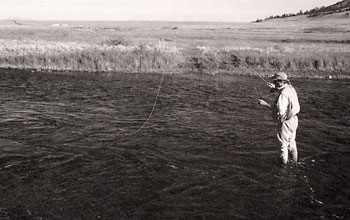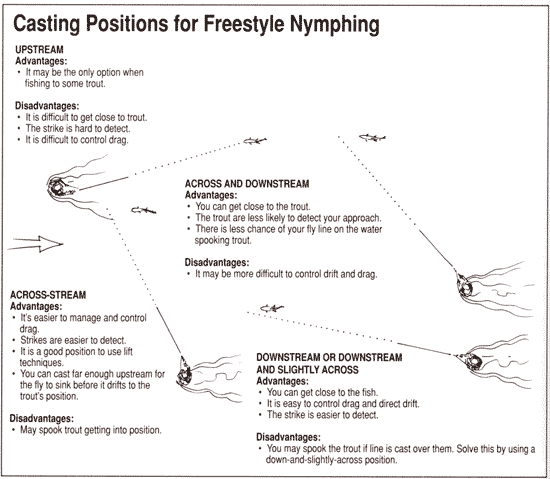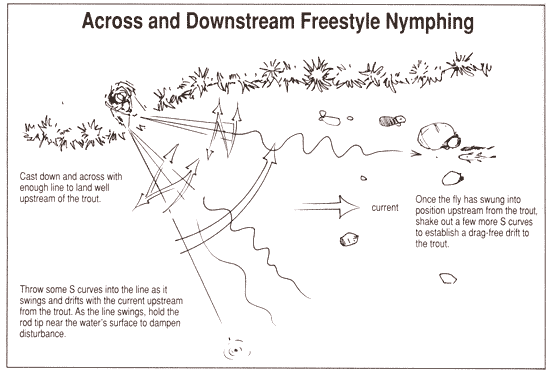Small-Fly Freestyle Nymphing
 FREESTYLE NYMPHING isn’t as new as it sounds. It’s actually the way that many of us learned how to fish larger nymph imitations. We later applied that knowledge to fishing small flies with a tiny split shot attached to the leader before strike indicators were in widespread use. Most recent innovations for weighting tiny flies have made pure freestyle nymphing techniques available to small-fly fishermen.
FREESTYLE NYMPHING isn’t as new as it sounds. It’s actually the way that many of us learned how to fish larger nymph imitations. We later applied that knowledge to fishing small flies with a tiny split shot attached to the leader before strike indicators were in widespread use. Most recent innovations for weighting tiny flies have made pure freestyle nymphing techniques available to small-fly fishermen.
The important elements of the small-fly basic freestyle nymphing technique are:
Get Close to Feeding Trout
Find a downstream (or downstream-and-slightly-across), across-and-downstream, across-stream, or upstream casting position in that order of preference. If you can stay on the bank without wading at all, do it. Find a downstream (or downstream-and-slightly-across), across-and-downstream, across-stream, or upstream casting position in that order of preference. If you can stay on the bank without wading at all, do it. Get as close to the feeding trout as possible. This will allow you, with the help of a good pair of sunglasses, to observe the trout and see it take the fly. If you can’t see the trout you will still be close enough to watch where the leader and water intersect. Use that intersection as your strike indicator. If the leader stops, hesitates, or does anything out of the ordinary, gently lift the rod. If you feel a fish on, set the hook; if you don’t feel a fish, lower the tip and continue the drift.
 Getting close to the fish allows you to keep the fly line off the water. As the fly drifts toward you, lift the rod higher and higher off the water to manage slack. It will also give you a natural drift and allow you to detect strikes more easily. If you need to make a somewhat longer cast and some fly line ends up on the surface, use the juncture where the butt of the leader and fly line are joined as a strike indicator.
Getting close to the fish allows you to keep the fly line off the water. As the fly drifts toward you, lift the rod higher and higher off the water to manage slack. It will also give you a natural drift and allow you to detect strikes more easily. If you need to make a somewhat longer cast and some fly line ends up on the surface, use the juncture where the butt of the leader and fly line are joined as a strike indicator.
The secret to successful freestyle nymphing and some dead-drift nymphing styles is not often clearly taught to beginners. If you’re not using a strike indicator, it is crucial that you keep the slack line off the water and the rod tip high. For many years I thought that keeping the tip up and the slack out was mainly to help with strike detection. That is indeed true, but keeping the rod tip up also suspends the fly just a bit as it drifts, and that’s what makes it act like the real thing. It also helps prevent snagging the stream bottom.
The closer you can get to the trout, the better your chances are of getting a natural drift with freestyle techniques. That’s why some people called it short-line nymphing when I first started nymphing thirty-five years ago.
Use a Weighted Fly to Match the Naturals
Recently, very fine wires, small brass and tungsten beads (1.5mm and 2mm), and the availability of small hooks made of heavier standard-size wires have made it possible to make weighted flies as small as size 24 or even size 26. Most fly fishers tie the tiny weighted flies to the tippet with a clinch knot. Tie the fly on with a tiny single surgeon’s loop if you feel the clinch knot is impeding its action.
Use a Long, Light Tippet
I usually use a 5X or 6X tippet when I freestyle nymph with small flies. Sometimes a very lightly weighted small fly will have trouble breaking through the surface tension. I’ve found that lengthening a nylon tippet to 3 feet or more will usually solve the problem, and more importantly, it gives the fly a better action under the surface. Of course, if getting the fly down becomes a problem, you can switch to fluorocarbon, which will break through the surface tension and sink a little better.
I often use freestyle nymphing techniques to fish to large trout that are in shallow, slow water near the banks. If it doesn’t spook the fish, I like fishing an imitation weighted with a bright gold, silver, or copper bead because I can often visually track the fly as it drifts downstream toward the trout. That way I know for sure that I got the drift right. Small-fly freestyle techniques are also effective in shallow riffles, seams, and the shallow slicks behind rocks. If you find that the trout are sensitive to the flashy metallic bead, switch to a fly where the weight is hidden under the dubbing.
Occasionally, you’ll find that the tiny splash of a small beadhead or weighted fly will spook the trout. If the fish is close in to the bank, try casting the fly lightly up on the bank and pulling it into the water. Your options will be limited if the trout is farther out in the stream. Sometimes it’s possible to cast farther upstream without scaring the trout, but be prepared to help the tiny nymph’s drift with a minilift here and there to get it over a rock or with a mid-drift correction with the rod tip to get it in front of the trout. You might also be able to cast the fly into a nearby riffle or seam to cover the splash.
 As a rule, a dead-drift presentation is best, but I do fool around with lifts once in a while. The well-known English nymphers G. E. M. Skues and later Frank Sawyer along with the American James Leisenring perfected the art of lifting a subsurface fly in front of feeding trout. They fished the nymph much like a dry fly by actually spotting feeding trout under the surface, casting a weighted fly upstream of the trout, allowing the fly to sink, and then gently lifting it in front of the trout as it drifted by. The movement often triggered an exciting strike.
As a rule, a dead-drift presentation is best, but I do fool around with lifts once in a while. The well-known English nymphers G. E. M. Skues and later Frank Sawyer along with the American James Leisenring perfected the art of lifting a subsurface fly in front of feeding trout. They fished the nymph much like a dry fly by actually spotting feeding trout under the surface, casting a weighted fly upstream of the trout, allowing the fly to sink, and then gently lifting it in front of the trout as it drifted by. The movement often triggered an exciting strike.
You will have to be in an across-and-downstream or across-stream casting position to make most lifts. I don’t get very fancy with it either. I just smoothly and slowly lift the tip of the rod either when I see the fly a few feet in front of the trout or when I figure it’s about in that position. Sometimes all it takes is a twitch. If a trout is responsive to lifts or twitches you’ll see it move immediately to the fly when you apply the action. Once again, it pays to be close when attempting lifts. You’ll have a chance of seeing the fly or at least seeing the trout, and you’ll have much better control over the lift.
I reserve the upstream casting position for when all my other options are depleted. It’s not that I can’t make an effective drag-free presentation from upstream, but rather that my chances of spooking the trout increase dramatically during the approach. I most often use the upstream approach for trout that are feeding close in to the bank. The key is to mark the trout’s location in relation to a streamside landmark, move well back from the bank, and then walk far enough upstream to remain undetected when you move back toward the stream. Once I’m next to the water, I crouch and sneak down toward the fish as close as I dare. The odds are that I won’t get close enough to see the trout, but I know its location because I can see where I marked it.
I then strip enough line off the reel for the cast and to feed line downstream as the fly drifts to the trout. The trick is to make the cast short enough to not spook the fish and then feed out slack with S curves of line. Strike detection can be problematical. Watch the leader–fly line connection closely and be sure to hold the fly line between your thumb and forefinger because you may be able to feel the strike. Also, closely watch the water’s surface. Sometimes you will get an inadvertent lift when fishing the nymph downstream, and you’ll see a little surface disturbance when the trout takes the fly.
If you think a straight downstream cast will spook the trout, consider making a short across-and-downstream cast and then allowing it to swing into the proper drift lane upstream from the trout. If you throw a few feet of slack into the line on the swing and hold the rod tip toward the water, it may dampen any surface disturbance caused when the line swings in the current. Once the fly has swung into position upstream of the trout, feed out S curves the same as you would do on a downstream presentation.
You may want to experiment with the tuck cast for certain small-fly freestyle nymphing situations. Joe Humphreys introduced the tuck cast in his bookTrout Tactics. Joe and George Harvey designed this upstream or upstream-and-across cast to create enough slack in the line to get a weighted nymph to the bottom before drag on the fly line affects it. Although the tuck cast works best for fishing larger weighted nymphs in anywhere from moderately moving to fast-moving water, you may find it useful when you need a bit more slack to get a small fly down deeper. In most small-fly nymphing situations, it will be necessary to add weight to the leader about 8 to 12 inches above a single fly because it’s difficult to weight a small fly enough to successfully make a tuck cast (see the section on small-fly dead-drift nymphing for details on using weight on the leader).
To execute this cast, stop the rod sharply at the 11 o’clock position of the forward cast with the last two fingers of the casting hand pulling the rod toward you while at the same time using the thumb to push it forward. This snap will overpower the loop, causing the weight and small fly to bounce back and tuck under the line. The fly will be propelled into the water with enough slack to allow it to get to the stream bottom before drag on the line lifts it. The fly usually makes a bit of a splash when it hits the surface, so you may want to cast a little farther upstream than you would in slower or shallower water.
As the fly drifts toward you, lift the rod tip higher to manage slack line and drag the same way you do for a standard freestyle nymphing presentation. Strikes are detected by watching the fish or the leader and water interface. For longer casts with some fly line on the water, watch the juncture between the fly line and leader butt to detect strikes.











